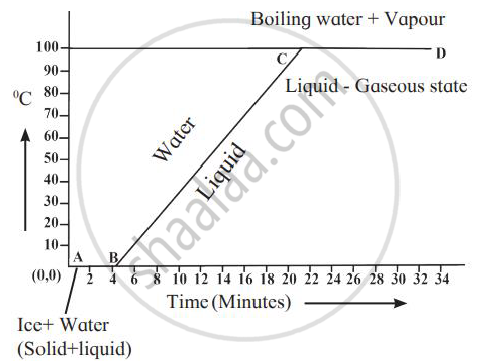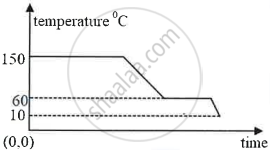Advertisements
Advertisements
Questions
State two characteristics of a good thermion emitter.
State the characteristics required of good thermion emitter
Solution
Characteristics of a good thermion emitter:
1) The work function of the substance should be low so that electrons may be emitted from it even when it is not heated to a high temperature.
2) The melting point of the substance should be high so that it may not melt when it is heated to the temperature required for thermionic emission.
RELATED QUESTIONS
A refrigerator converts 100g of water at 20℃ to ice at – 10℃ in 73.5 min. Calculate the average rate of heat extraction in watt. The specific heat capacity of water is 4.2 J kg-1 K-1, specific latent heat of ice is 336 J g-1 and the specific heat capacity of ice is 2.1 J kg-1 K-1.
Explain the following temperature vs time graph.

What is the name given to the energy absorbed during a phase change?
Name two factors on which the heat absorbed or given out by a body depends.
What happens to the heat supplied to a substance when the heat supplied causes no change in the temperature of the substance?
When 1 g of ice at 0 °C melts to form 1 g of water at 0 °C then, is the latent heat absorbed by the ice or given out by it?
Give one consequence of the high specific latent heat of fusion of ice.
Why does weather become pleasant when it starts freezing in cold countries?
Explain the meaning of greenhouse effect.
Derive an expression for the amount of heat given out or taken up, when its temperature falls or rises by t°C.
If there is no Heat loss to the surroundings, the heat released by the condensation of m1 g of steam at 100°C into water at 100°C can be used to convert m2 g of ice at 0°C into water at 0°C.
(i) Find:
(a) The heat lost by steam in terms of m1
(b) The heat gained by ice in terms of m2
(ii) Form a heat equation find the ratio of m2 : m1
Specific latent heat of vaporization of steam = 2268 kJ/kg
Specific latent heat of fusion of ice = 336 kJ/kg
Specific heat capacity of water = 4200 J/kg°C
When ice is converted into water : constant temperature : : before the water evaporates : _______
Define boiling point of a liquid.
Match the columns.
| Column A | Column B |
| 1) Absolute humidity | a) J or cal |
| 2) Latent heat | b) J/kg °C |
| 3) Specific heat capacity | c) kJ/kg |
| 4) Heat | d) no unit |
| e) kg/m3 |
Who introduced the term latent heat?
Calculate the amount of heat required to convert 200g of ice at 0°C into the water at 0°C Specific latent heat of fusion of ice = 336 Jg-1
2875 J of heat is required to melt 115 g of lead at its melting point. Calculate the specific latent heat capacity of fusion of lead.
Calculate the total amount of heat energy required to melt 200 g of ice at 0°C to water at 100°C. (Specific latent heat of ice = 336 Jg-1, specific heat capacity of water = 4.2 Jg-1 °C-1)
The diagram below shows a cooling curve for a substance:

- State the temperatures at which the substance condenses.
- The temperature range in which the substance is in liquid state.
- Why do we prefer ice to ice-cold water for cooling a drink?
